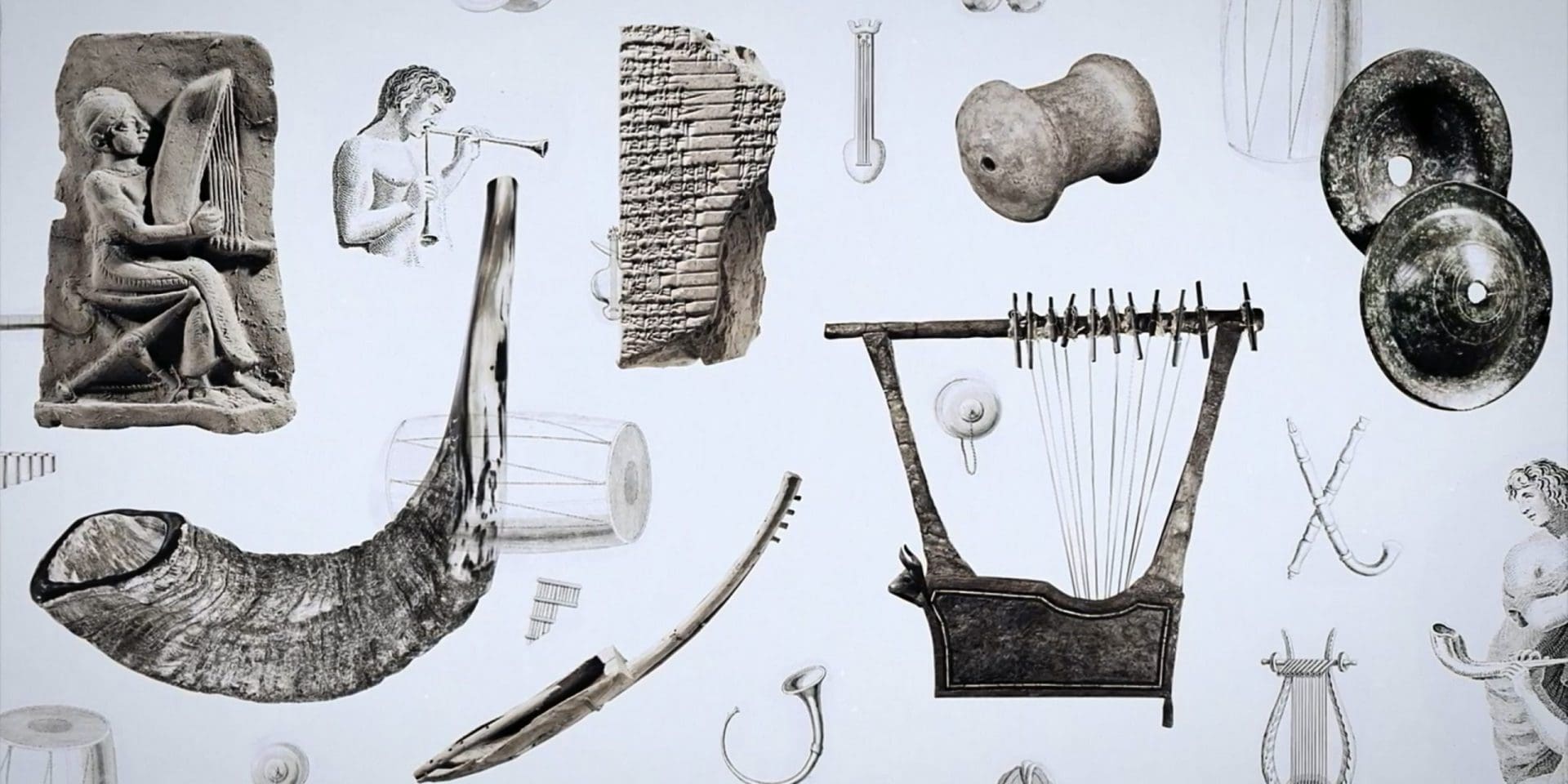The Bible, like the ancient cultures that it represents, is full of music! As far back as historians can see, music has been a part of human life: From the rock gongs (lithophones) of pre-history to the intricate bull lyres of Ur, mankind is musical. The Bible’s first mention of music comes from Genesis 4, an origin story of sorts. Jubal, whose name itself means “ram’s horn” or “trumpet” is given credit for inventing the “harp and flute”, or lyre and pipe, perhaps, the double flute that shows up in many ancient depictions alongside the lyre.
Knowledge of ancient musical instruments has come down to us through physical remains, artistic depictions (paintings, carvings, clay impressions, sculptures) and literary evidence. These sources have verified that instruments were made from diverse materials: wood, reed, animal gut and hide, metal, pottery, bone and ivory.[1] Of course, some of these materials are easily preserved while others tend to rot with time and regular wear.
“It is said [of a horned beast] that while it lives it has only one voice, but when it is dead it has seven voices.”
In the percussion realm drums made of stretched hide, and tambourines (without today’s common jingles) are known to have been used, but decay quite easily, so far none have been found from ancient Israel. Rattles, cymbals and bells are a different story. Many have been found. Before the invention of bells as we know them (9th Century BC), pottery rattles or shakers were popular.[2] Metal sistrums, bronze cymbals, and noisy jewelry like bracelets and anklets round out this category.
In the woodwind camp, there is the now famous Second Temple Period (6th Century BC – 1 Century AD) bone flute that was discovered in the city of David excavations.[3] Many types of flutes existed in the ancient Near East, but they weren’t the only instrument that utilized a type of bone. Animal horns were used to create trumpets or shofars. Trumpets could also be made out of metal. We know from Numbers 10 that silver trumpets were made for public events and ceremonies of Israel. Interestingly, metal trumpets may have had an association with the lotus flower whose shape certainly is trumpet like. An example of this association was discovered in King Tut’s tomb, his silver trumpet and its wooden insert are decorated with the lotus.[4][5] In the book of Psalms there are several sections that are to be played “according to the lilies” or “according to the lotus” (Psalm 45, 60, 69, 80), this may mean they were songs played with trumpets.[6]
Listed in David’s worship roster for the Temple, were stringed harps and lyres. These lyres came in many forms and sizes, from ones that sat on the floor to handheld.[7] From modern reconstructions it’s known that larger lyres played in lower registers than the smaller handheld styles.[8]
In Psalms, there are several references to the gates of Jerusalem, and worshipping in the gate structure of the city (Psalm 9:14; 24:7-9; 100:4; 118:19-20; 122:2). This seems to have been a regular place to play music, sing and dance as evidenced by the Bible, and by carvings of musicians that adorned the gates of a few discovered Hittite cities.[9]


Later on, Jewish tradition records that “It is said [of a horned beast] that while it lives it has only one voice, but when it is dead it has seven voices … Its two horns [are fashioned into] two trumpets; its two legbones [are made into] two flutes; its hide [is made into] a drum; its large intestine is [made into strips] for harps; and its small intestines are used for citherns.”[10]
All of these instrumental remains from physical to literary have captured the imaginations of researchers for decades. For some of the more musically inclined, ancient Mesopotamian pieces of music (from Ugarit, fragments of Hurrian cult songs) have even been somewhat deciphered revealing complex chording that records both melody and harmony. Tempo, ornamentation and vocal accompaniment still remain a mystery.[11]

Corie Bobechko is a daily co-host, speaker, and writer of Bible Discovery. She also hosts a YouTube channel that shows how history and archaeology prove the Bible. Her heart for seekers and skeptics has led her to seek truth and share it with others. Corie also has a Bachelor of Theology from Canada Christian College.
[1] Bayer, Bathja. “The Finds That Could Not Be,” Biblical Archaeology Review 8.1 (1982): 20–33.
[2] Bayer.
[3] “How Scholarly Communication Works,” Biblical Archaeology Review 8.1 (1982): 36–37.
[4] Staubli, Thomas. “Archaeological Views: Performing Psalms in Biblical Times,” Biblical Archaeology Review 44.1 (2018): 62–63.
[5] https://www.the-sun.com/lifestyle/tech/19349/tutankhamuns-cursed-trumpet-that-causes-deadly-conflict-has-arrived-in-the-uk/
[6] Staubli.
[7] Mitchell, Terence C. “And the Band Played On…But What Did They Play On?” Bible Review 15.6 (1999): 32–39.
[8] “World’s Oldest Musical Notation Deciphered on Cuneiform Tablet,” Biblical Archaeology Review 6.5 (1980): 14–19, 23–25.
[9] Staubli.
[10] Mishna, Kinnim 3:6. Referenced from “How Scholarly Communication Works,” Biblical Archaeology Review 8.1 (1982): 36–37.
[11] “World’s Oldest Musical Notation Deciphered on Cuneiform Tablet,” Biblical Archaeology Review 6.5 (1980): 14–19, 23–25.






